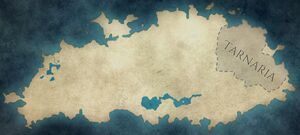Tarnaria
Tarnaria /tɑr'næriːə/ or /tɑr'nɑriːə/ is a loosely defined region which encompasses the east part of the Continent and is connected by languages, politics and the Xaewoon religion. Yammoe is not considered part of Tarnaria and has been largely responsible for the propagation of the concept of Tarnaria as a backcountry.
The significance of Tarnaria as an identifier has gone down in the past several centuries, mostly due to the formation of multiple states, whereas for the majority of its history Tarnaria was fairly decentralized and nomadic due to the dominance of the Mōroh philosophy, especially in the north.
First settlers have arrived by the beginning of the 16th CFR. By the mid of the 17th century the state of Asdoh had been established, followed by the Empire of Barud and Toor.
Origins of the concept
Historically, Tarnaria's western borders were defined by the Taverda river in the north, by Kwalee, Loodori, Rowlow, Kwalin and Ybuwyn in the south and by Yammoe, Gantolia and Teamatian in the center. Its eastern border is defined by the ocean and the Nanonae.
Some researchers reject the term and regard it as politically, socially and culturally meaningless, as it encompasses too vast a territory and too many peoples to provide a meaningful moniker.
The concept of "Tarnaria" can be traced to Yammoe and its view of itself as the counterpart to the Western Dantrian civilization, which culminated in the project of the Eastern Dantrian civilization. Tarnaria was a dismissive term that essentially meant "backcountry" (doranar, doranary) and referred to anything to the east of Yammoe, including the countries of the second wave. In fact, when the term became more widespread, it found its way back to Yammoe as "Tarnaria" and became synonymous with "doranary".
Yammoe's domination of the region allowed it to command the narrative that undermined the true diversity of cultures of Tarnaria and painted it as sparsely inhabited swaths of land, united by a single language and religion. This was further exacerbated by the downfall of the highly developed Asdoh and Barud and the rise of Mōroh, which essentially created an appearance that Yammoean narrative was right all along.
In reality, Asdoh was as developed, if not more developed, than Yammoe during the first revolution, and was a far better representative of the Western Dantrian civilization in its culture, technology, society and political structure.
The Xaewoon religion and the bukkean family of languages, although indeed a strong uniting cultural element, do not apply to large swaths of the eastern Continent, specifically its southeastern part, which neither follows Xaewoon, nor speaks Bukk. Loodori's Kajoon Tarkai, although served as the origins of Xaewoon, is an entirely different religion, and the incorporation of Loodori's ancient Jabi has always been unidirectional.
But even throughout the second revolution, the term Tarnaria excluded the southeastern part and was understood as the central and northern regions of the eastern Continent. Some historians even exclude the Utuka, arguing that their participation in Tarnarian events, if not influence, has been minimal.
History
The history of Tarnaria is divided into several periods: pre-historic and early Tarnaria, the Asdoh Period, the Age of Mōroh, the Mantareia Period and others.
The Asdoh Period
The Asdoh Period marks the beginning of an accelerated migration of the Dawn peoples to Tarnaria and the establishment of several key states, such as Asdoh, Barud and Toor, which defined the political, cultural and religious makeup of Tarnaria. It spans a period of roughly 700 years, from the 16th CFR to the end of the 2nd CSR.
The amount of sources of the Asdoh Period is very limited, leaving researchers with either incomplete or very one-sided accounts. While the overall history of the period is corroborated by multiple non-Tarnarian sources, the vast majority of details about the workings and people of the major states comes from two authors: Ludoh and Porteek.
Writes Mlan:
Ludoh and Porteek have left us with two very distinct accounts, each helpful and problematic in different ways. While in Ludoh the amount of detail is tempered by the problem of demarcation between fact and fiction, Porteek's analytical and sourced narrative is rife with intelligently intertwined bias: Porteek had very strong opinions about major historical figures and their choices.
The Age of Mōroh that followed the Asdoh Period diligently destroyed numerous historical sources and actively rewritten Tarnarian history, resulting in the move from the Great Lore to Swift Hen, a monumental propaganda project that was successfully completed by the 3rd CSR.
The only reason that Ludoh's and Porteek's works were preserved is due to copies of these treaties finding their way into Loodori, Gantolia and Yammoe.
Politics and society
Throughout the first and second revolutions, Tarnarian governance has largely been monarchical. For many centuries the system of governance was built around an ancient dantrian system, imported to Tarnaria through the Dawn settlers and implemented in such early civilizations as Asdoh, Toor and Barud. It was then slightly repurposed, although generally kept intact, for the traveling kingdoms of Mōroh. In the beginning of the 17th CSR first Qep and then Mantareia evolved the system into what is today the system of assemblic monarchy.
